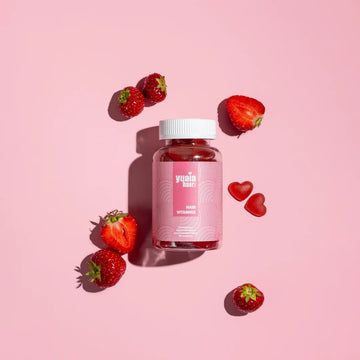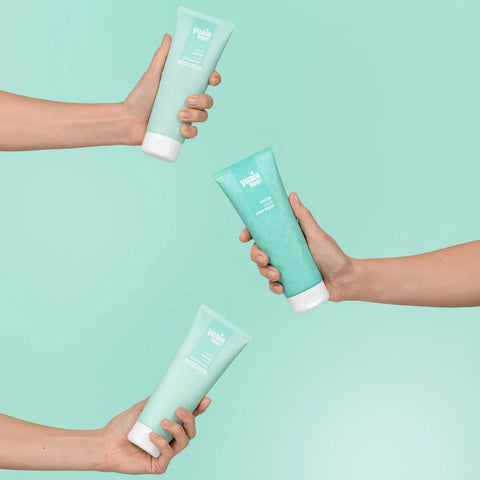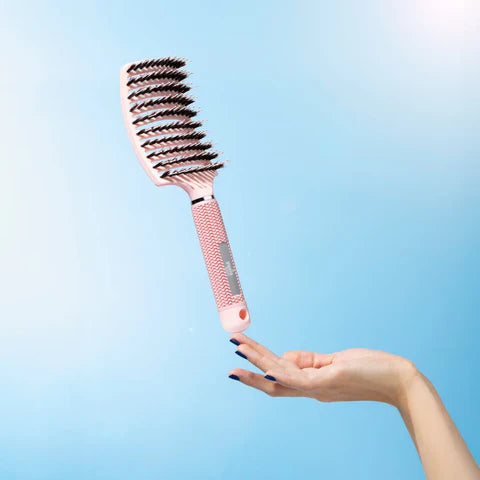
Signs of protein overload in hair: How to identify and restore balance
by Nanna Bundgaard on Jun 18, 2025

Read through by Dorthe Kristensen
Hairdresser and former co-owner of the award-winning hairdressing chain Zoom by Zoom
With many years of experience in the hairdressing industry, Dorthe has advised many customers about hair and hair care. Dorthe has read through this blog entry to ensure high quality and professionalism. This blog post is professionally updated on June 18, 2025.
Table of contents
Maintaining the balance: Why it matters
In the world of hair care, achieving the perfect balance between protein and moisture is key to maintaining healthy, vibrant hair. This balance is crucial because while proteins are essential for strengthening hair, an excess can lead to a condition known as protein overload. This issue has become a growing concern among hair enthusiasts, as more individuals are turning to protein-rich products without realizing the potential drawbacks.
What is protein overload?
Protein overload occurs when the hair absorbs too much protein, disrupting its natural balance and leading to various hair health issues. While proteins like keratin are vital for hair strength and structure, too much can cause the hair to become rigid and less flexible. This rigidity can result in hair that is prone to breakage and lacks the natural shine and elasticity that healthy hair should have.
Why is protein overload problematic?
Many people use protein-rich products, such as conditioners and treatments, to strengthen their hair. However, overuse can lead to protein overload, which shows as dry, brittle, and unmanageable hair. This is particularly problematic because, while the intention is to enhance hair health, the result is often the opposite. Understanding the signs of protein overload is the first step in addressing and restoring balance.
To prevent and manage protein overload, it's important to assess the products you use and how they might contribute to this issue. Recognizing the signs early can help you adjust your hair care routine accordingly. Stay tuned for our next section, where we'll delve deeper into identifying these signs and exploring effective solutions to restore your hair's natural balance.
Identifying the signs of protein overload
Recognizing the symptoms of protein overload in your hair is crucial for restoring its health and vitality. One of the most noticeable signs is dryness and brittleness. Hair that is overloaded with protein often feels dry to the touch and snaps easily when handled. This lack of moisture can lead to a straw-like texture, making the hair feel coarse and stiff.
Another common indication is the loss of shine and dullness. Hair that once appeared lustrous may suddenly lose its natural glow, appearing lifeless and dull. This change is often accompanied by breakage and split ends, as the excess protein makes the hair more prone to damage.
Protein overload can also cause a loss of elasticity. Healthy hair should stretch and return to its original shape, but with too much protein, it may break instead of stretching. This is particularly evident in those with curly or wavy hair, where changes in curl pattern, such as loss of definition or increased frizz, become apparent.
Another symptom to watch for is increased tangles and shedding. Hair may become more difficult to detangle and shed more frequently, especially during brushing or washing. This can make it difficult to manage, as hair becomes resistant to styling and doesn’t hold shapes well.
Causes of protein overload
The primary cause of protein overload is the overuse of protein-rich products. Many hair care products contain hydrolyzed proteins and amino acids, which are beneficial in moderation but can lead to overload when used excessively. It's important to be mindful of the ingredients in your hair care products and use them wisely to avoid this issue.
It's also crucial to understand that protein overload is not linked to dietary protein intake. Instead, it results from topical hair treatments. Therefore, monitoring the types of products you use and how frequently you use them is key to preventing protein overload.
How to differentiate from other hair issues
Distinguishing protein overload from other hair issues, such as moisture overload, can be challenging but is essential for proper treatment. A simple at-home test, like the stretch test, can help diagnose your hair's condition. To perform this test, take a single hair and gently stretch it. If it breaks easily without much stretching, protein overload may be the cause. In contrast, if it stretches too much before breaking, moisture overload might be the issue.
Restoring balance: Methods to correct protein overload
For those facing protein overload, adjusting your hair care routine is essential to restore balance and health. One of the first steps is to reduce protein-rich product usage. Opt for products with a balanced formula that does not heavily rely on proteins. This can help prevent further protein accumulation and allow your hair to regain its natural state.
Another effective strategy is using moisture-rich treatments. Deep conditioning treatments can replenish lost moisture, enhancing your hair's softness and manageability. Consider incorporating our Rosemary Hair Oil into your routine. This product is excellent for hydrating the hair without adding extra protein, making it ideal for addressing protein overload.
In addition to product adjustments, gentle hair care practices play a crucial role in managing protein overload. Using a brush that evenly distributes natural oils, like our Curvy Brush, can improve hair texture and reduce breakage. Gentle brushing helps maintain hair health by ensuring oils reach the hair ends, which are often the driest parts.
Regular trims are also important. By maintaining regular trims, you can manage split ends and breakage, which are common issues when dealing with protein overload. Trimming damaged ends allows healthier hair to grow and flourish.
Embracing hair health
Achieving optimal hair health requires listening to your hair's needs and making necessary adjustments to your care routine. By maintaining a balance between protein and moisture, you can ensure your hair remains vibrant and healthy. Remember, hair care is not a one-size-fits-all approach; it requires attention and adaptation to your hair's unique requirements.
Frequently asked questions
What are the most common signs of protein overload in hair?
Common signs include dryness, brittleness, loss of elasticity, a straw-like texture, and increased tangles. These symptoms indicate that your hair may have absorbed too much protein.
How can I test if my hair has protein overload?
One simple method is the stretch test. Gently stretch a single strand of hair; if it breaks easily without much stretching, it may be overloaded with protein.
Can I reverse protein overload?
Yes, with proper care and adjustments to your hair care routine, you can restore balance. Focus on reducing protein-rich products and increasing moisture in your regimen.
What should I avoid to prevent protein overload?
Avoid excessive use of protein-rich products. Instead, focus on maintaining a balance by using moisture-rich treatments and monitoring your hair's response to different products.
Get a 10% discount code sent to you
Receive the best tips and tricks for your hair from Lotte and Nanna 🥰
 2-5 day delivery
2-5 day delivery
 25.000+ satisfied customers
25.000+ satisfied customers
 Satisfaction Guarantee
Satisfaction Guarantee













